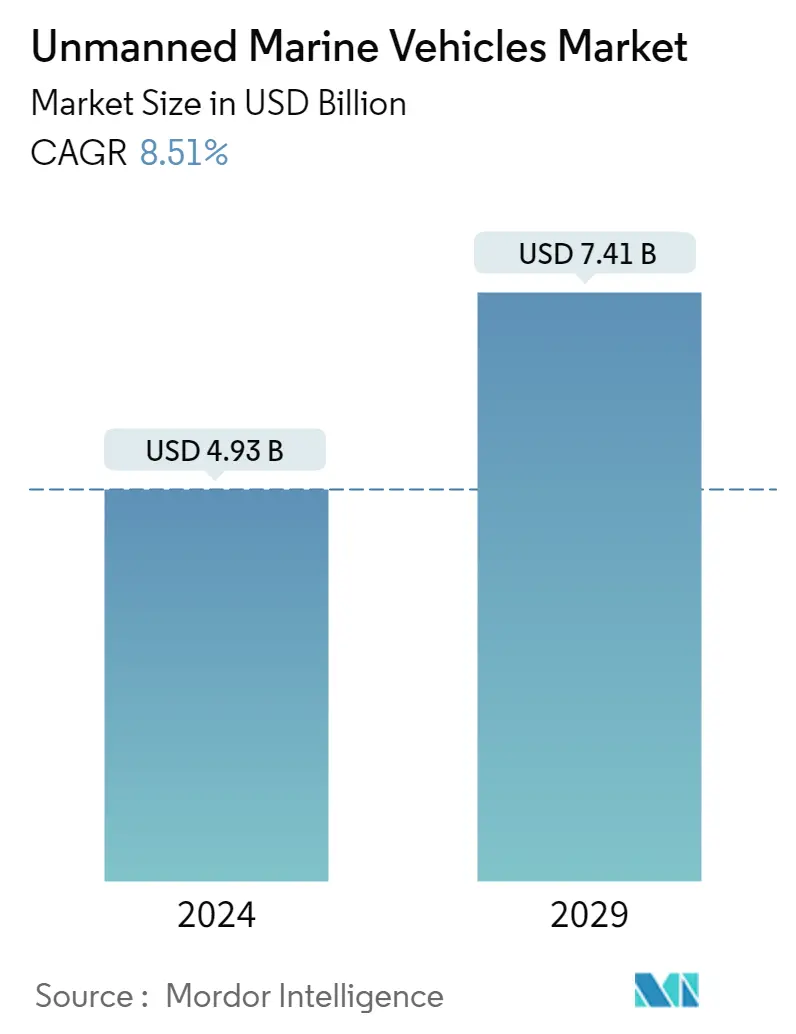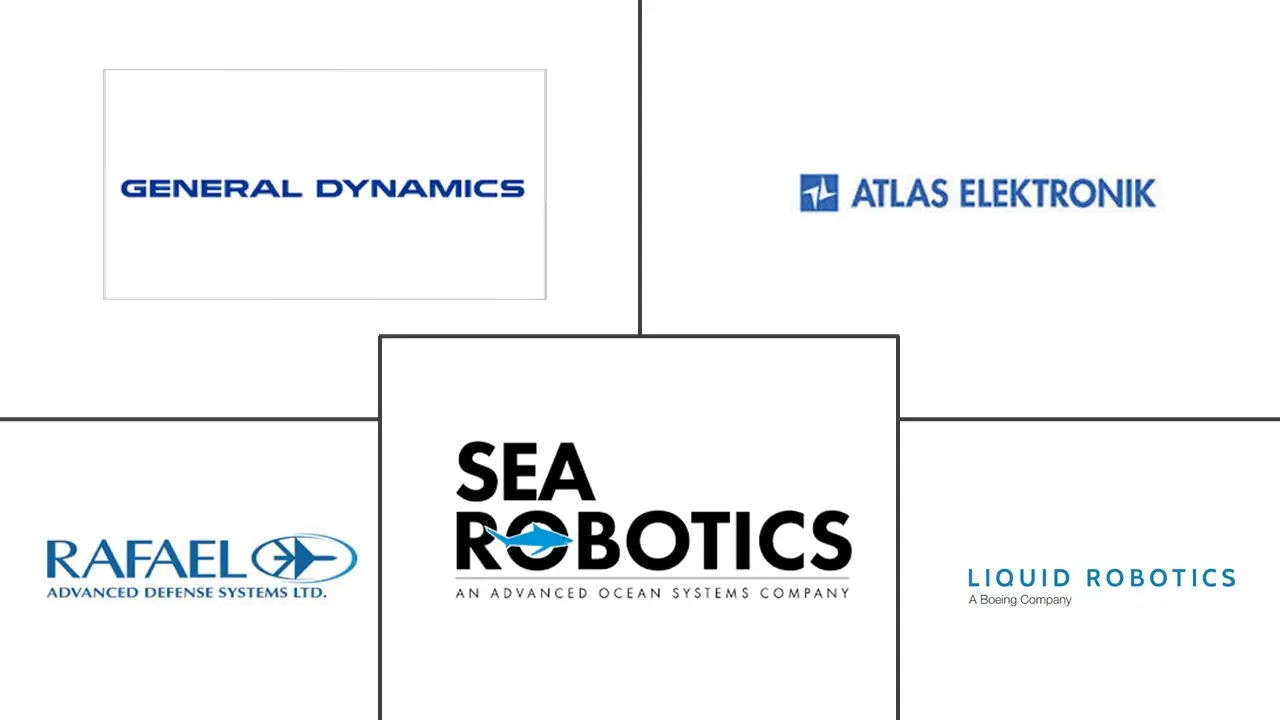Market Size of Unmanned Marine Vehicles Industry

| Study Period | 2019 - 2029 |
| Market Size (2024) | USD 4.93 Billion |
| Market Size (2029) | USD 7.41 Billion |
| CAGR (2024 - 2029) | 8.51 % |
| Fastest Growing Market | Asia-Pacific |
| Largest Market | North America |
| Market Concentration | Low |
Major Players
*Disclaimer: Major Players sorted in no particular order |
Unmanned Marine Vehicles Market Analysis
The Unmanned Marine Vehicles Market size is estimated at USD 4.93 billion in 2024, and is expected to reach USD 7.41 billion by 2029, growing at a CAGR of 8.51% during the forecast period (2024-2029).
With rapid technological development, acoustic sensors for high underwater navigation are on trend. The aim is to reduce the cost and latency of current underwater navigation systems that typically employ high accuracy.
- Oceanic surveillance is driving the market for defense purposes as unmanned marine vehicles offer greater capacity for surveillance, identification, and interception than traditional systems. They can be equipped with stabilized weapons systems, surveillance systems, and electro-optical tracking systems capable of monitoring day and night using infrared vision.
- In addition to operational cost reductions and platform design, improvements in sensors would reduce costs by reducing science payload power requirements and enable the usage of progressively smaller platforms. Improved sensors, platforms' interoperability, and interfaces would significantly reduce costs.
- The ideal sensor for future autonomous platforms would be cost-effective, interoperable, compact, web-enabled, and self-identifying. Cost-effective sensors may be suitable for the large-scale production of unmanned marine vehicles and could utilize features of modern electronics, such as positioning, communication, and miniaturization. Various sensor types, such as vision sensors, Light Detection and Ranging (LiDAR), infrared, sonar, and radar, are used on USVs to navigate while avoiding obstacles safely.
- Increased usage of unmanned marine vehicles for underwater mapping, particularly for marine geoscience studies, is expected to drive the market's growth. More emphasis in the future will be directed toward documenting the various stable states of Earth's systems, discovering what events trigger evolution from one stable state to another, and identifying the linkages between the states of very different systems like climate and tectonics activity, which will drive the need for unmanned marine vehicles.
- However, the high cost of UMVs and the associated maintenance issues may hinder the market in the short term. This challenge is expected to minimize its impact on the market in the long run as companies develop more advanced systems and gain more expertise in providing maintenance services.
- The COVID-19 pandemic has negatively impacted the overall marine industry, and crewless marine vehicles are no exception. Various preventive measures that various governments took across the world to contain the spread of the virus severely disrupted the supply chains across industries and hampered the manufacturing operations of several companies globally.
Unmanned Marine Vehicles Industry Segmentation
The unmanned marine vehicles market includes autonomous underwater vehicles, remotely operated vehicles, semi-submersibles, and unmanned surface craft. The defense sector is increasingly adopting, in addition to commercial sectors, to map and monitor the conditions of the sea or ocean and explore various oil and gas sites.
The study covers unmanned marine vehicles that include surface vehicles and underwater vehicles. Unmanned vehicles that operate completely on the surface are part of surface vehicles (USV). Subsurface and underwater vehicles are part of the underwater vehicle segment (UUV). Further, the study covers the applications of unmanned marine vehicles that include defense, commercial, and research.
| Type | |
| Surface Vehicle | |
| Underwater Vehicle |
| Control Type | |
| Remotely Operated | |
| Autonomous |
| Application | |
| Defense | |
| Research | |
| Commercial | |
| Other Applications |
| Geography | |||||||
| |||||||
| |||||||
| |||||||
| |||||||
|
Unmanned Marine Vehicles Market Size Summary
The unmanned marine vehicles market is poised for significant growth, driven by advancements in technology and increasing demand for defense applications. The market is experiencing a surge in interest due to the development of cost-effective and compact sensors that enhance the capabilities of unmanned surface vehicles (USVs) and autonomous underwater vehicles (AUVs). These vehicles are becoming integral to oceanic surveillance, offering superior surveillance, identification, and interception capabilities compared to traditional systems. The defense sector, in particular, is investing heavily in these technologies to address maritime security threats, such as underwater mines and anti-ship missiles. The market is also witnessing a rise in the use of unmanned marine vehicles for underwater mapping and marine geoscience studies, further fueling its expansion.
Despite the promising growth trajectory, the market faces challenges, including the high costs and maintenance issues associated with unmanned marine vehicles. However, these challenges are expected to diminish as companies innovate and streamline maintenance processes. The COVID-19 pandemic has also impacted the market by disrupting supply chains and manufacturing operations. Nevertheless, the market is recovering, with key players like General Dynamics, Atlas Elektronik, and Sea Robotics Inc. actively engaging in strategic initiatives such as partnerships and product launches to strengthen their market positions. Europe is emerging as a significant growth region, driven by both defense and commercial sector demands, with countries like the United Kingdom and Germany leading advancements in unmanned marine vehicle technologies.
Unmanned Marine Vehicles Market Size - Table of Contents
-
1. MARKET OVERVIEW
-
1.1 Market Overview
-
1.2 Industry Value Chain Analysis
-
1.3 Industry Attractiveness - Porter's Five Forces Analysis
-
1.3.1 Threat of New Entrants
-
1.3.2 Bargaining Power of Buyers
-
1.3.3 Bargaining Power of Suppliers
-
1.3.4 Threat of Substitute Products
-
1.3.5 Intensity of Competitive Rivalry
-
-
1.4 Assessment of the Impact of COVID-19 on the Market
-
-
2. MARKET SEGMENTATION
-
2.1 Type
-
2.1.1 Surface Vehicle
-
2.1.2 Underwater Vehicle
-
-
2.2 Control Type
-
2.2.1 Remotely Operated
-
2.2.2 Autonomous
-
-
2.3 Application
-
2.3.1 Defense
-
2.3.2 Research
-
2.3.3 Commercial
-
2.3.4 Other Applications
-
-
2.4 Geography
-
2.4.1 North America
-
2.4.1.1 United States
-
2.4.1.2 Canada
-
-
2.4.2 Europe
-
2.4.2.1 Germany
-
2.4.2.2 Italy
-
2.4.2.3 France
-
2.4.2.4 Rest of Europe
-
-
2.4.3 Asia-Pacific
-
2.4.3.1 China
-
2.4.3.2 Japan
-
2.4.3.3 India
-
2.4.3.4 Australia
-
2.4.3.5 Rest of Asia-Pacific
-
-
2.4.4 Latin America
-
2.4.4.1 Brazil
-
2.4.4.2 Rest of Latin America
-
-
2.4.5 Middle-East and Africa
-
2.4.5.1 South Africa
-
2.4.5.2 Rest of Middle-East and Africa
-
-
-
Unmanned Marine Vehicles Market Size FAQs
How big is the Unmanned Marine Vehicles Market?
The Unmanned Marine Vehicles Market size is expected to reach USD 4.93 billion in 2024 and grow at a CAGR of 8.51% to reach USD 7.41 billion by 2029.
What is the current Unmanned Marine Vehicles Market size?
In 2024, the Unmanned Marine Vehicles Market size is expected to reach USD 4.93 billion.

